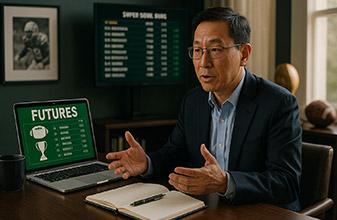Avoiding a Reverse Middle

King Yao is the author of Weighing the Odds in Hold‘em Poker, and Weighing the Odds in Sports Betting. He uses his experience from making millions in financial derivative markets and translates it into gambling. Since he left his trading position in 2000, he has been playing poker and betting on sports. He travels to Las Vegas frequently, especially during football season.
Prospective sports bettors should know the basic principles of sports betting. You should not be betting sports online or anywhere else without this fundamental knowledge.
In our previous article, the mistake was making a negative-Expected Value (“EV”) bet as a hedge when the line moves. Avoiding a positive-EV hedge because it creates a reverse middle is the opposite mistake.
Bettors who make this mistake are worried about the small possibility of losing both the initial bet and the hedge. In the previous article, the mistake is paying too much to get into a middle opportunity. Here, the mistake is giving up a positive-EV opportunity to avoid a possible reverse middle. Here is an example:
Initial bet: Philadelphia Eagles -5.5 -110 vs. Green Bay Packers
You have handicapped this game and think the fair line is Philadelphia -7, and thus you think there is positive EV in taking Philadelphia -5.5 -110.
Later in the week, there is news that the Philadelphia quarterback has injured his throwing hand in practice and is out for the rest of the season. You reevaluate the Eagles without him and now handicap the fair line as Philadelphia -2.5. The line has not moved down as much, and you have the opportunity to make this positive-EV bet that is also a hedge:
Possible positive-EV hedge: Green Bay +3.5 -110 vs. Philadelphia.
You think the fair line is Philadelphia -2.5. That means a bet of Green Bay +3.5 -110 has positive EV. Even though making this bet would put you into a possible reverse middle when combined with the original bet of Eagles -5.5, you should still make the bet because it is a positive-EV bet. If you had not made the initial bet, you would have been happy to bet Green Bay +3.5. You should be happy to make that bet even though you have already made the other bet.
Unfortunately, some bettors will avoid this positive-EV hedge because they are scared of creating a reverse middle and losing both sides. This can happen: If the Eagles win by exactly 4 or 5 points, both bets will lose. But given the handicapped numbers that you generated, you should be making the bet because the EV is great relative to the risk of being middled. It is possible that the risk of being middled is too great in some situations, but it is important to analyze those risks and compare them to the EV rather than avoiding them just because of the possibility of a reverse middle.
Increasing Risk with a Hedge
A correlation of zero means the two bets are not related; winning one wager gives no information about how likely the other wager is to win. Looking to hedge means looking for a bet negatively correlated to your initial wager. If there is close to zero correlation, then there is no hedge, and the bet is evaluated just like any other independent bet.
This is part of an occasional series of articles.
Excerpted with permission from the e-book version of Weighing the Odds in Sports Betting by King Yao, edited for this format.











Please log in or register to leave a comment